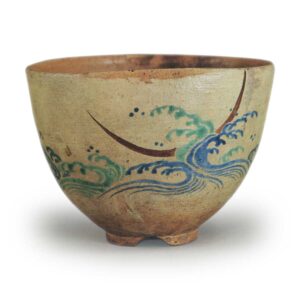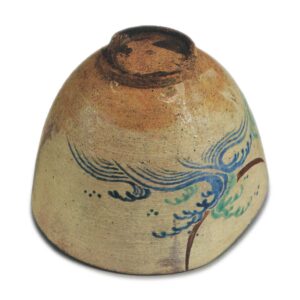

Held in the collection of the Tokyo National Museum
Height: 9.2-9.4cm
Diameter: 11.7-12.6cm
Outer diameter of foot ring: 4.8cm
Height of foot ring: 0.6cm
The elegant shape, which is like a lotus seed cut in half horizontally, is reminiscent of the Gohon tea bowl, which is one of the Joseon tea bowls, and the clearly carved foot is similar to that of the Goki tea bowls. Therefore, it can be said that the shape of these tea bowls, which were fired during the Yi Dynasty and were called Goryeo tea bowls at the time, were used as models.
However, the way the painted upper part is distorted as if it had come into contact with another vessel during firing, and the way the foot ring, which is slightly thin on one side, has a half-moon-shaped cut in one place and the inside of the foot ring is scraped in two layers, are very Japanese in style. This shows that the Korean tea bowl was not copied directly.
The skill of the potter’s wheel that is apparent in the construction of the foot ring can also be seen in the extremely thin body, and the white glaze that has been applied is so thin that the streaks of the water marks left on the clay surface can clearly be seen. Furthermore, the glaze is like dried glue, and is different from the moist glaze commonly seen on Ninshō ware.
The glaze is left unpainted on the warped part of the rim and the foot ring, or on part of the underside of the foot ring, revealing the original clay surface, but the clay texture visible there is also coarse, unlike the fine clay often seen on tea bowls, and is more like that used for pots. The fact that the glaze on the underside of the foot ring is left unpainted in the area where the seal is impressed is a sign of the great importance that Nisei attached to the mark of his kiln.
The design of the waves colored with indigo glaze on the outside is also seen in other examples of Nisei ware, but compared to these, the design is rather crude. Also, the gold used to depict the crescent moon is a dull color, and is not as bright as the gold seen in other Ninshō ware.
It is thought that Ninshō opened his kiln in front of Ninna-ji Temple in the fourth year of the Shōhō era, and that he took the name Ninshō a few years later, around the Meireki era. The glaze and application of the white glaze on this tea bowl, as well as the painting and glaze color, give it a sense of being unfinished, and it is thought that this tea bowl was fired early in Ninshō’s career.
In addition, on the plain cedar box that this tea bowl is stored in,
it is written in ink
“From the Sowa era, Ninwaji ware
tea bowl, Shunryo
”, but we have no idea who this Shunryo is.



